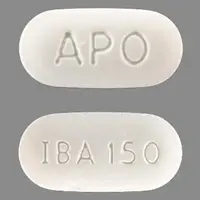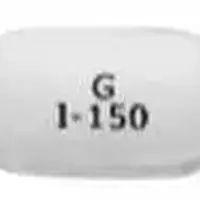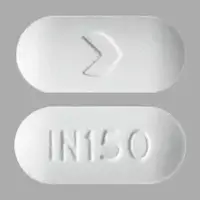Generic name: boniva
Availability: Prescription only
Pregnancy & Lactation: Risk data available
Brand names: Boniva, Ibandronate (oral/injection)
What is Ibandronate (monograph)?
Introduction
Synthetic bisphosphonate; bone resorption inhibitor.
Uses for Ibandronate
Osteoporosis
Prevention of osteoporosis in postmenopausal women. Risk factors for postmenopausal osteoporosis and related fractures include early menopause, advanced age, low bone mineral density (BMD), low body mass index (BMI), previous fracture or family history of fracture/osteoporosis, excessive alcohol intake, smoking, inadequate physical activity, low calcium and vitamin D intake, certain drugs (e.g., glucocorticoids), and medical conditions or diseases (e.g., rheumatoid arthritis, diabetes mellitus, Cushing syndrome, hyperparathyroidism).
Treatment of osteoporosis in postmenopausal women.
In addition to adequate intake of calcium/vitamin D and other lifestyle modifications (e.g., exercise, avoidance of excessive alcohol and tobacco use), experts recommend that pharmacologic therapy for osteoporosis be considered in postmenopausal women with previous hip or vertebral fractures or low BMD; pharmacologic therapy also may be considered in postmenopausal women with low bone mass, although there is less evidence supporting overall fracture risk reduction in such patients.
Use of a drug with proven efficacy in reducing fracture risk is recommended; bisphosphonates (e.g., alendronate, risedronate, zoledronic acid, ibandronate) are recommended as one of several first-line drugs.
Individualize choice of therapy based on potential benefits (with respect to fracture risk reduction) and adverse effects of therapy, patient preferences, comorbidities, and risk factors.
Glucocorticoid-induced Osteoporosis
Also has been used in the management of glucocorticoid-induced osteoporosis† [off-label].
American College of Rheumatology (ACR) recommends optimizing calcium and vitamin D intake and lifestyle modifications (e.g., diet, smoking cessation, weight-bearing or resistance-training exercise) in all patients receiving long-term glucocorticoid therapy; in addition, pharmacologic therapy with an oral bisphosphonate is recommended in patients who are considered to be at moderate-to-high risk of fracture. Oral bisphosphonates generally are preferred because of their demonstrated antifracture benefits, safety, and low cost.
Related/similar drugs
hydrochlorothiazide, alendronate, estradiol, Prolia, Fosamax, calcium carbonate, ReclastIbandronate Dosage and Administration
General
-
Correct hypocalcemia and other disturbances of bone and mineral metabolism prior to initiation of therapy.
-
Provide supplemental calcium and vitamin D if dietary intake is inadequate.
Administration
Oral Administration
Administer orally with a full glass (180–240 mL) of plain water ≥60 minutes prior to the first food, beverage (other than plain water), or other orally administered drug or supplement (including vitamins, antacids, and calcium) of the day. (See Food under Pharmacokinetics.)
Avoid lying down for ≥60 minutes following administration.
Do not to suck or chew tablets; potential for oropharyngeal ulceration. (See Upper GI Effects under Cautions.)
If a morning daily oral dose is missed, do not take missed dose later that same day. Resume the regular schedule the next day.
When administered monthly, take tablets in the morning on the same day each month. If a monthly dose is missed and the next scheduled dose is more than 7 days away, take the missed dose the next morning after it is remembered and resume the regular schedule. If the next scheduled dose is 1–7 days away, maintain the regular schedule; do not take more than one 150-mg tablet within the same week.
IV Administration
Administer by IV injection once every 3 months by a health-care professional.
Injection must only be administered IV. Safety and efficacy of IV injection administered by other routes not established.
Because of the risk of anaphylaxis or other severe hypersensitivity reactions, appropriate medical support should be readily available during IV administration. (See Hypersensitivity under Cautions.)
If a dose is missed, reschedule administration with a health-care professional as soon as possible. Schedule subsequent injections at 3-month intervals; should not be administered more often than once every 3 months.
Administration Risks
Take care to avoid intra-arterial or paravenous injection as such administration could result in tissue damage.
Rate of Administration
Administer IV over a period of 15–30 seconds.
Dosage
Available as ibandronate sodium (as the monosodium monohydrate); dosage expressed in terms of ibandronate.
Adults
Osteoporosis
Prevention in Postmenopausal Women
Oral150 mg once monthly.
Osteoporosis
Treatment in Postmenopausal Women
Oral150 mg once monthly.
Optimal duration of treatment not established. Safety and efficacy based on data over 3 years. Reevaluate need for continued therapy periodically in all patients receiving bisphosphonates. Consider discontinuance of bisphosphonate therapy after 3–5 years in patients at low risk of fracture. Evaluate fracture risk periodically in patients who discontinue therapy.
IV
3 mg once every 3 months.
Optimal duration of treatment not established. Safety and efficacy of IV ibandronate based on data supporting fracture reduction over 1 year of treatment. Reevaluate need for continued therapy periodically in all patients receiving bisphosphonates. Consider discontinuance of bisphosphonate therapy after 3–5 years in patients at low risk of fracture. Evaluate fracture risk periodically in patients who discontinue therapy.
Special Populations
Renal Impairment
Oral or IV
Dosage adjustments not necessary in patients with mild to moderate renal impairment (Clcr ≥30 mL/minute); use not recommended in patients with severe renal impairment (Clcr <30 mL/minute).
Warnings
Contraindications
-
Oral: Esophageal abnormalities that delay esophageal emptying (e.g., stricture, achalasia).
-
Oral and IV: Uncorrected hypocalcemia.
Oral and IV: Known hypersensitivity to ibandronate or any ingredient in the formulation.
-
Oral: Inability to stand or sit upright for ≥60 minutes.
Warnings/Precautions
Upper GI Effects
Possible severe adverse esophageal effects (e.g., esophagitis, esophageal ulcers, erosions, strictures, perforation). (See Oral Administration under Dosage and Administration.) Monitor for any manifestations and discontinue if dysphagia, odynophagia, new or worsening heartburn, or retrosternal pain occurs.
Use with caution in patients with active upper GI disease (e.g., Barrett’s esophagus, dysphagia, other esophageal diseases, gastritis, duodenitis, ulcers). Gastric and duodenal ulcers (some severe and with complications) reported during postmarketing experience.
Route of Administration
Injection must be administered IV by a health-care professional; do not administer by non-IV (e.g., intra-arterial) routes. (See Administration Risks under Dosage and Administration.)
Metabolic Effects
Correct hypocalcemia, hypovitaminosis D, and other disturbances of bone and mineral metabolism before initiating therapy.
If daily intake inadequate, administer supplemental calcium and vitamin D.
Osteonecrosis of the Jaw
Osteonecrosis and osteomyelitis of the jaw reported in patients receiving bisphosphonates. Most cases associated with tooth extraction and/or local infection with delayed healing. Known risk factors include cancer, concomitant therapies (e.g., chemotherapy, corticosteroids, angiogenesis inhibitors), poor oral hygiene, and comorbid disorders (e.g., periodontal and/or other preexisting dental disease, anemia, coagulopathy, infection, ill-fitting dentures). Risk also may be increased with increased duration of bisphosphonate use.
If osteonecrosis of the jaw develops, consult an oral surgeon for treatment. Dental surgery may exacerbate condition.
In patients requiring dental procedures, discontinuance of therapy prior to procedure may reduce the risk of osteonecrosis of the jaw. Base management of patients requiring dental treatment on an individual assessment of risks and benefits.
Musculoskeletal Pain
Severe and occasionally incapacitating bone, joint, and/or muscle pain reported infrequently with bisphosphonate therapy. Time to onset varied from 1 day to years (mean onset about 3 months) after treatment initiation. If severe symptoms occur, consider discontinuing drug. Such pain generally improves following discontinuance, but may recur upon subsequent rechallenge with the same drug or another bisphosphonate.
Atypical Fracture of the Femur
Atypical (subtrochanteric or diaphyseal) femur fractures reported rarely with long-term use (>3 years) of bisphosphonates, mostly in patients receiving these drugs for osteoporosis. Often occurs with minimal or no trauma, and may be bilateral. Causality not established; atypical fractures also occur in osteoporotic patients not receiving bisphosphonates. Risk may be increased with concomitant use of glucocorticoid, estrogen, and proton-pump inhibitor therapy.
Evaluate patients who present with new thigh or groin pain for possibility of an atypical femoral fracture; include assessment of the contralateral limb. Consider interruption of bisphosphonate therapy in patients with manifestations of possible femoral fracture; weigh risks versus benefits of continued treatment. Discontinue if a femoral shaft fracture is confirmed.
Atrial Fibrillation
Although data are conflicting, possible increased risk of atrial fibrillation with use of bisphosphonates. FDA analysis of data from long-term (6 months to 3 years) controlled trials identified a higher rate of atrial fibrillation in patients receiving bisphosphonates (alendronate, ibandronate, risedronate, or zoledronic acid) versus placebo; however, only a few events reported in each study. FDA is continuing to monitor this safety concern.
Potential Risk of Esophageal Cancer
Some evidence (from postmarketing experience and observational studies) suggests a possible association between use of oral bisphosphonates and an increased risk of esophageal cancer. However, because of conflicting data, additional study needed to confirm such findings.
FDA states that benefits of oral bisphosphonates continue to outweigh their potential risks in patients with osteoporosis; it is important to consider that esophageal cancer is rare, especially in women.
Avoidance of oral bisphosphonates in patients with Barrett’s esophagus, a known precursor to esophageal adenocarcinoma, has been recommended.
Renal Effects
Possible renal toxicity (e.g., deterioration of renal function and, rarely, renal failure) with bisphosphonates. Risk may be greater in patients with coexisting conditions associated with renal impairment, concomitant therapy with other nephrotoxic drugs, preexisting renal disease, dehydration, dosage, infusion volume and rate, and multiple cycles of treatment. Assess renal function in such patients.
Use not recommended in patients with severe renal impairment (Clcr <30 mL/minute).
Measure Scr prior to each IV dose. Withhold treatment if deterioration of renal function occurs.
Sensitivity Reactions
Hypersensitivity
Hypersensitivity reactions, including fatal anaphylaxis in patients who received ibandronate injection, reported. (See Contraindications under Cautions and see IV Administration under Dosage and Administration.)
Specific Populations
Pregnancy
No data in pregnant women to inform any drug-associated risks. In reproductive animal studies, maternal and fetal toxicity (including postimplantation loss, developmental anomalies, and deaths) observed.
Lactation
Distributed into milk in rats; not known whether distributed into human milk. Also not known whether the drug has any effects on the nursing infant or milk production.
Pediatric Use
Safety and efficacy not established in children. Not indicated for use in children.
Geriatric Use
No substantial differences in safety and efficacy relative to younger adults, but increased sensitivity cannot be ruled out. Consider age-related decreases in renal function.
Renal Impairment
Use not recommended in patients with severe renal impairment (CLcr <30 mL/minute).
Common Adverse Effects
Oral: Back pain, dyspepsia, pain in the extremities, diarrhea, headache, myalgia.
IV: Arthralgia, back pain, abdominal pain.
How should I use Ibandronate (monograph)
General
-
Correct hypocalcemia and other disturbances of bone and mineral metabolism prior to initiation of therapy.
-
Provide supplemental calcium and vitamin D if dietary intake is inadequate.
Administration
Oral Administration
Administer orally with a full glass (180–240 mL) of plain water ≥60 minutes prior to the first food, beverage (other than plain water), or other orally administered drug or supplement (including vitamins, antacids, and calcium) of the day. (See Food under Pharmacokinetics.)
Avoid lying down for ≥60 minutes following administration.
Do not to suck or chew tablets; potential for oropharyngeal ulceration. (See Upper GI Effects under Cautions.)
If a morning daily oral dose is missed, do not take missed dose later that same day. Resume the regular schedule the next day.
When administered monthly, take tablets in the morning on the same day each month. If a monthly dose is missed and the next scheduled dose is more than 7 days away, take the missed dose the next morning after it is remembered and resume the regular schedule. If the next scheduled dose is 1–7 days away, maintain the regular schedule; do not take more than one 150-mg tablet within the same week.
IV Administration
Administer by IV injection once every 3 months by a health-care professional.
Injection must only be administered IV. Safety and efficacy of IV injection administered by other routes not established.
Because of the risk of anaphylaxis or other severe hypersensitivity reactions, appropriate medical support should be readily available during IV administration. (See Hypersensitivity under Cautions.)
If a dose is missed, reschedule administration with a health-care professional as soon as possible. Schedule subsequent injections at 3-month intervals; should not be administered more often than once every 3 months.
Administration Risks
Take care to avoid intra-arterial or paravenous injection as such administration could result in tissue damage.
Rate of Administration
Administer IV over a period of 15–30 seconds.
Dosage
Available as ibandronate sodium (as the monosodium monohydrate); dosage expressed in terms of ibandronate.
Adults
Osteoporosis
Prevention in Postmenopausal Women
Oral150 mg once monthly.
Osteoporosis
Treatment in Postmenopausal Women
Oral150 mg once monthly.
Optimal duration of treatment not established. Safety and efficacy based on data over 3 years. Reevaluate need for continued therapy periodically in all patients receiving bisphosphonates. Consider discontinuance of bisphosphonate therapy after 3–5 years in patients at low risk of fracture. Evaluate fracture risk periodically in patients who discontinue therapy.
IV
3 mg once every 3 months.
Optimal duration of treatment not established. Safety and efficacy of IV ibandronate based on data supporting fracture reduction over 1 year of treatment. Reevaluate need for continued therapy periodically in all patients receiving bisphosphonates. Consider discontinuance of bisphosphonate therapy after 3–5 years in patients at low risk of fracture. Evaluate fracture risk periodically in patients who discontinue therapy.
Special Populations
Renal Impairment
Oral or IV
Dosage adjustments not necessary in patients with mild to moderate renal impairment (Clcr ≥30 mL/minute); use not recommended in patients with severe renal impairment (Clcr <30 mL/minute).
What other drugs will affect Ibandronate (monograph)?
Does not induce or inhibit CYP isoenzymes (i.e., CYP1A2, 2A6, 2C9, 2C19, 2D6, 2E1, or 3A4) and is not metabolized.
Antacids or Mineral Supplements Containing Divalent Cations
Pharmacokinetic interaction (decreased absorption of ibandronate) when tablets are used concomitantly with antacids or mineral supplements containing divalent cations (e.g., aluminum, calcium, magnesium, iron). Administer tablets ≥60 minutes prior to such drugs or supplements.
Drugs Affecting Hepatic Microsomal Enzymes
Pharmacokinetic interactions unlikely.
Drugs Excreted through Renal Tubular Transport
Based on limited data in animals, not excreted through renal tubular transport. Pharmacokinetic interaction unlikely.
Nephrotoxic Agents
Potential pharmacologic interaction (increased risk of renal toxicity). Assess patients taking concomitant nephrotoxic agents. (See Renal Effects under Cautions.)
Specific Drugs and Tests
|
Drug |
Interaction |
Comments |
|---|---|---|
|
Bone-imaging agents |
Potential to interfere with use of bone-imaging agents |
|
|
Histamine H2-receptor antagonists |
Increased oral bioavailability of ibandronate No evidence of increased adverse upper GI effects |
Not considered clinically important |
|
Melphalan |
Pharmacokinetic interaction unlikely with IV ibandronate |
|
|
NSAIAs |
No evidence of increased adverse upper GI effects |
Use concomitantly with caution |
|
Prednisolone |
Pharmacokinetic interaction unlikely with IV ibandronate |
|
|
Tamoxifen |
Pharmacokinetic interaction unlikely with IV ibandronate |







